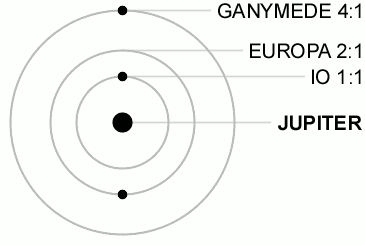Rocks/Rocky objects/Ganymede
< Rocks < Rocky objects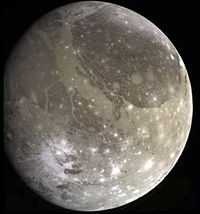
"If Ganymede rotated around the Sun rather than around Jupiter, it would be classified as a planet."[1]
The Galilean Moons is a "name given to Jupiter's four largest moons, Io, Europa, Callisto & Ganymede. They were discovered independently by Galileo Galilei and Simon Marius."[2]
Planetary sciences

"Ganymede has a very distinct surface with bright and dark regions. The surface includes mountains, valleys, craters and lava flows. The darker regions are more heavily littered with craters implying that those regions are older. The largest dark region is named Galileo Regio and is almost 2000 miles [3200 km] in diameter. The lighter regions display extensive series of troughs and ridges, thought to be a result of tectonic movement."[1]
"A notable attribute of the craters on Ganymede is that they are not very deep and don’t have mountains around the edges of them as can normally be seen around craters on other moons and planets. The reason for this is that the crust of Ganymede is relatively soft and over a geological time frame has flattened out the extreme elevation changes."[1]
Color astronomy

A "Voyager 2 image [is at the right] of Jupiter's largest moon Ganymede. This image was taken on 2 July 1979, from 6 million km, 6 days before Voyager 2's closest approach to the satellite. The light bluish regions near the north and south poles are visible in this image, possibly a result of water ice or frost."[3] The dark brown features at the top of Ganymede are shown on other images of this side of Ganymede.
Theoretical Ganymede
Def. one of the Galilean moons of Jupiter, the seventh closest satellite to the planet and the largest satellite in the solar system with a diameter of 3,268 miles (5,260 km) is called Ganymede.
X-rays
"Apart from the Sun, the known X-ray emitters now include planets (Venus, Earth, Mars, Jupiter, and Saturn), planetary satellites (Moon, Io, Europa, and Ganymede), all active comets, the Io plasma torus, the rings of Saturn, the coronae (exospheres) of Earth and Mars, and the heliosphere."[4]
Violets
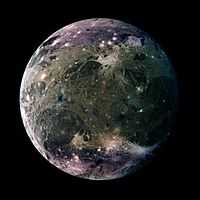
"In this global view of Ganymede's trailing side, the colors are enhanced to emphasize color differences. The enhancement reveals frosty polar caps in addition to the two predominant terrains on Ganymede, bright, grooved terrain and older, dark furrowed areas. Many craters with diameters up to several dozen kilometers are visible. The violet hues at the poles may be the result of small particles of frost which would scatter more light at shorter wavelengths (the violet end of the spectrum). Ganymede's magnetic field, which was detected by the magnetometer on NASA's Galileo spacecraft in 1996, may be partly responsible for the appearance of the polar terrain. Compared to Earth's polar caps, Ganymede's polar terrain is relatively vast. The frost on Ganymede reaches latitudes as low as 40 degrees on average and 25 degrees at some locations. For comparison with Earth, Miami, Florida lies at 26 degrees north latitude, and Berlin, Germany is located at 52 degrees north."[5]
"North is to the top of the picture. The composite, which combines images taken with green, violet, and 1 micrometer filters, is centered at 306 degrees west longitude. The resolution is 9 kilometers (6 miles) per picture element. The images were taken on 29 March 1998 at a range of 918000 kilometers (570,000 miles) by the Solid State Imaging (SSI) system on NASA's Galileo spacecraft."[5]
Oranges
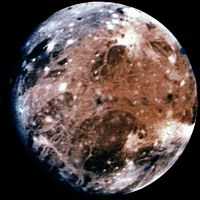
If taken through the clear filter, the image at right suggests much of the surface of Ganymede was reflecting in the orange portion of the visual spectrum.
Infrareds
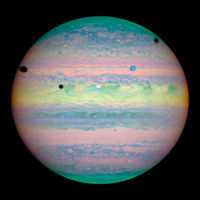
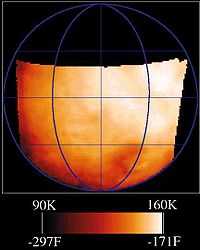
The image at right shows Jupiter in the near infrared. "Five spots -- one colored white, one blue, and three black are scattered across the upper half of the planet. Closer inspection by NASA's Hubble Space Telescope reveals that these spots are actually a rare alignment of three of Jupiter's largest moons -- Io, Ganymede, and Callisto -- across the planet's face. In this image, the telltale signatures of this alignment are the shadows [the three black circles] cast by the moons. Io's shadow is located just above center and to the left; Ganymede's on the planet's left edge; and Callisto's near the right edge. Only two of the moons, however, are visible in this image. Io is the white circle in the center of the image, and Ganymede is the blue circle at upper right. Callisto is out of the image and to the right. ... Jupiter appears in pastel colors in this photo because the observation was taken in near-infrared light. Astronomers combined images taken in three near-infrared wavelengths to make this color image. The photo shows sunlight reflected from Jupiter's clouds. In the near infrared, methane gas in Jupiter's atmosphere limits the penetration of sunlight, which causes clouds to appear in different colors depending on their altitude. Studying clouds in near-infrared light is very useful for scientists studying the layers of clouds that make up Jupiter's atmosphere. Yellow colors indicate high clouds; red colors lower clouds; and blue colors even lower clouds in Jupiter's atmosphere. The green color near the poles comes from a thin haze very high in the atmosphere. Ganymede's blue color comes from the absorption of water ice on its surface at longer wavelengths. Io's white color is from light reflected off bright sulfur compounds on the satellite's surface. ... In viewing this rare alignment, astronomers also tested a new imaging technique. To increase the sharpness of the near-infrared camera images, astronomers speeded up Hubble's tracking system so that Jupiter traveled through the telescope's field of view much faster than normal. This technique allowed scientists to take rapid-fire snapshots of the planet and its moons. They then combined the images into one single picture to show more details of the planet and its moons."[6]
The second image at the right shows an infrared image of Ganymede.
Atmospheres
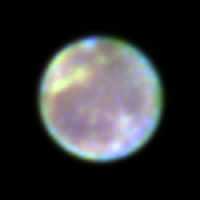
"Though ozone may be diminishing on Earth, it is being manufactured one-half billion miles away, on Jupiter's largest satellite, Ganymede."[7]
"NASA's Hubble Space Telescope found ozone's spectral "fingerprint" during observations of Ganymede made by Keith Noll and colleagues at the Space Telescope Science Institute in Baltimore, Maryland. These Hubble Faint Object Spectrograph results were presented at the American Astronomical Society's 27th Annual Meeting of the Division of Planetary Sciences in Kona, Hawaii."[7]
Craters
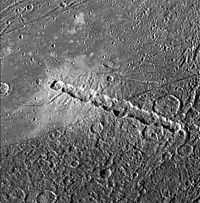
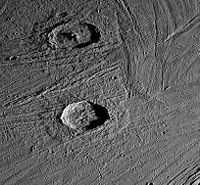

The image at right shows a chain of 13 craters (Enki Catena) on Ganymede measuring 161.3 km in length. "The Enki craters formed across the sharp boundary between areas of bright terrain and dark terrain, delimited by a thin trough running diagonally across the center of this image. The ejecta deposit surrounding the craters appears very bright on the bright terrain. Even though all the craters formed nearly simultaneously, it is difficult to discern any ejecta deposit on the dark terrain."[8]
"Cratering is seen on both types of terrain [third image at right], but is especially extensive on the dark terrain: it appears to be saturated with impact craters and has evolved largely through impact events.[9] The brighter, grooved terrain contains many fewer impact features, which have been only of a minor importance to its tectonic evolution.[9] The density of cratering indicates an age of 4 billion years for the dark terrain, similar to the highlands of the Moon, and a somewhat younger age for the grooved terrain (but how much younger is uncertain).[10] Ganymede may have experienced a period of heavy cratering 3.5 to 4 billion years ago similar to that of the Moon.[10] If true, the vast majority of impacts happened in that epoch, while the cratering rate has been much smaller since.[11] Craters both overlay and are crosscut by the groove systems, indicating that some of the grooves are quite ancient. Relatively young craters with rays of ejecta are also visible.[11][12] Ganymedian craters are flatter than those on the Moon and Mercury. This is probably due to the relatively weak nature of Ganymede's icy crust, which can (or could) flow and thereby soften the relief. Ancient craters whose relief has disappeared leave only a "ghost" of a crater known as a palimpsest.[11]"[13]
The second image at right is an "[o]blique view of two fresh impact craters in bright grooved terrain near the north pole of Jupiter's moon, Ganymede. The craters postdate the grooved terrain since each is surrounded by swarms of smaller craters formed by material which was ejected out of the crater as it formed, and which subsequently reimpacted onto the surrounding surface. The crater to the north, Gula, which is 38 kilometers (km) in diameter, has a distinctive central peak, while the crater to the south, Achelous, (32 km in diameter) has an outer lobate ejecta deposit extending about a crater radius from the rim. Such images show the range of structural details of impact craters, and help in understanding the processes that form them."[14]
"North is to the top of the picture and the sun illuminates the surface from the right. The image, centered at 62 degrees latitude and 12 degrees longitude, covers an area approximately 142 by 132 kilometers. The resolution is 175 meters per picture element. The images were taken on April 5, 1997 at 6 hours, 33 minutes, 37 seconds Universal Time at a range of 17,531 kilometers by the Solid State Imaging (SSI) system on NASA's Galileo spacecraft."[14]
In the third image at right "[t]he ancient, dark terrain of Nicholson Regio (left) shows many large impact craters, and zones of fractures oriented generally parallel to the boundary between the dark and bright regions of Jupiter's moon Ganymede. In contrast, the bright terrain of Harpagia Sulcus (right) is less cratered and relatively smooth."[15]
"The nature of the boundary between ancient, dark terrain and younger, bright terrain, the two principal terrain types on Ganymede, was explored by NASA's Galileo spacecraft on May 20, 2000. Subtle parallel ridges and grooves show that Harpagia Sulcus's land has been smoothed out over the years by tectonic processes."[15]
"North is to the top of the picture. The Sun illuminates the surface from the left. The image, centered at ?14 degrees latitude and 319 degrees longitude, covers an area approximately 213 by 97 kilometers (132 by 60 miles.) The resolution is 121 meters (about 250 feet) per picture element. The images were taken on May 20, 2000, at a range of 11,800 kilometers (about 7,300 miles)."[15]
Gravity astronomy
In the general case only planets (with their satellites) and stars could be considered "as free, as possible" to be used as some "antenna" to the gravitational waves detection. Spherical megascopic bodies have the folloving characteristic impedance:
where
 is the equatorial velocity,
is the equatorial velocity,  spherical body radius and
spherical body radius and  body mass.
body mass.
| Body name | Body radius, m | Equator velocity, m/s | Body mass, kg | Body impedance |  |
|---|---|---|---|---|---|
| Moon |  |
4.36 |  |
 |
 |
| Titan |  |
276.8 |  |
 |
 |
| Ganymede |  |
1116 |  |
 |
 |
| Callisto |  |
252.7 |  |
 |
 |
Satellite data are taken from the textbook[16] As may be seen from the table, only the Moon has the closest value of characteristic impedance about 12-times greater than for free space.
Astroglaciology
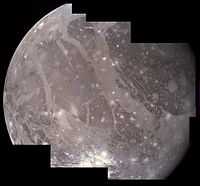
"Ganymede is composed of approximately equal amounts of silicate rock and water ice."[13]
"The average density of Ganymede, 1.936 g/cm3, suggests a composition of approximately equal parts rocky material and water, which is mainly in the form of ice.[9] The mass fraction of ices is between 46–50%, slightly lower than that in Callisto.[17] Some additional volatile ices such as ammonia may also be present.[17][18]"[13]
"Water ice seems to be ubiquitous on the surface, with a mass fraction of 50–90%,[9] significantly more than in Ganymede as a whole. Near-infrared spectroscopy has revealed the presence of strong water ice absorption bands at wavelengths of 1.04, 1.25, 1.5, 2.0 and 3.0 μm.[19] The grooved terrain is brighter and has more icy composition than the dark terrain.[20]"[13]
"The forces that caused the strong stresses in the ganymedian ice lithosphere necessary to initiate the tectonic activity may be connected to the tidal heating events in the past, possibly caused when the satellite passed through unstable orbital resonances.[9][21] The tidal flexing of the ice may have heated the interior and strained the lithosphere, leading to the development of cracks and horst and graben faulting, which erased the old, dark terrain on 70% of the surface.[9][22] The formation of the grooved terrain may also be connected with the early core formation and subsequent tidal heating of the moon's interior, which may have caused a slight expansion of Ganymede by 1–6% due to phase transitions in ice and thermal expansion.[9]"[13]
"Ganymede also has polar caps, likely composed of water frost. The frost extends to 40° latitude.[23] These polar caps were first seen by the Voyager spacecraft. Theories on the caps' formation include the migration of water to higher latitudes and bombardment of the ice by plasma. Data from Galileo suggests the latter is correct.[24]"[13]
"Additional evidence of the oxygen atmosphere comes from spectral detection of gases trapped in the ice at the surface of Ganymede. The detection of ozone (O3) bands was announced in 1996.[25] In 1997 spectroscopic analysis revealed the dimer (or diatomic) absorption features of molecular oxygen. Such an absorption can arise only if the oxygen is in a dense phase. The best candidate is molecular oxygen trapped in ice. The depth of the dimer absorption bands depends on latitude and longitude, rather than on surface albedo—they tend to decrease with increasing latitude on Ganymede, while O3 shows an opposite trend.[26] Laboratory work has found that O2 would not cluster or bubble but dissolve in ice at Ganymede's relatively warm surface temperature of 100 K.[27]"[13]
"[H]eavy ions continuously precipitate on the polar surface of the moon, sputtering and darkening the ice.[28]"[13]
Astrognosy
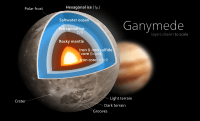
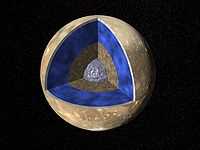
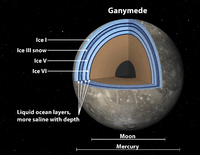
A variety of models have been suggested for the interior constitution of Ganymede. The first diagram at the right suggests ice, water, and an iron-based core.
The first image at the left suggests another interior: "The cut-out reveals the interior structure of this icy moon. This structure consists of four layers based on measurements of Ganymede's gravity field and theoretical analyses using Ganymede's known mass, size and density. Ganymede's surface is rich in water ice and Voyager and Galileo images show features which are evidence of geological and tectonic disruption of the surface in the past. As with the Earth, these geological features reflect forces and processes deep within Ganymede's interior. Based on geochemical and geophysical models, scientists expected Ganymede's interior to either consist of: a) an undifferentiated mixture of rock and ice or b) a differentiated structure with a large lunar sized "core" of rock and possibly iron overlain by a deep layer of warm soft ice capped by a thin cold rigid ice crust. Galileo's measurement of Ganymede's gravity field during its first and second encounters with the huge moon have basically confirmed the differentiated model and allowed scientists to estimate the size of these layers more accurately. In addition the data strongly suggest that a dense metallic core exists at the center of the rock core. This metallic core suggests a greater degree of heating at sometime in Ganymede's past than had been proposed before and may be the source of Ganymede's magnetic field discovered by Galileo's space physics experiments."[29]
The second image at the right suggests a variety of pressure-related ices similar to the model directly above it.
This "new model, based on experiments in the laboratory that simulate salty seas, shows that the ocean and ice may be stacked up in multiple layers, more like a club sandwich."[30]
"Ice comes in different forms depending on pressures. "Ice I," the least dense form of ice, is what floats in your chilled beverages. As pressures increase, ice molecules become more tightly packed and thus more dense. Because Ganymede's oceans are up to 500 miles (800 kilometers) deep, they would experience more pressure than Earth's oceans. The deepest and most dense form of ice thought to exist on Ganymede is called "Ice VI." [...] With enough salt, liquid in Ganymede can become dense enough to sink to the very bottom of the seafloor, below Ice VI. [...] What's more, the model shows that a strange phenomenon might occur in the uppermost liquid layer, where ice floats upward. In this scenario, cold plumes cause Ice III to form. As the ice forms, salt precipitates out. The salt then sinks down while the ice "snows" upward. Eventually, this ice would melt, resulting in a slushy layer in Ganymede's club sandwich structure."[30]
Astromorphology
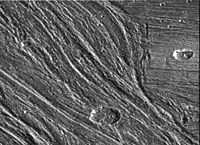
"Complex sets of ridges and grooves are visible in this image of the Nippur Sulcus region on Jupiter's largest moon Ganymede. NASA's Galileo spacecraft imaged this region as it passed Ganymede during its second orbit through the Jovian system. The Nippur Sulcus region is an example of Bright Terrain on Ganymede which is typified by multiple sets of ridges and grooves. The intersections of these sets reveal complex age relationships. North is to the top of the picture and the sun illuminates the surface from the southeast (lower right). In this image a younger sinuous northwest-southeast trending groove set cuts through and apparently destroys the older east-west trending features on the right of the image, allowing scientists to determine the sequence of events that led to the region's formation. The area contains many impact craters. The large crater in the bottom of the image is about 12 kilometers (8 miles) in diameter."[31]
"The image, centered at 51 degrees latitude and 204 degrees longitude, covers an area approximately 79 kilometers (50 miles) by 57 kilometers (36 miles) across. The resolution is 93 meters (330 feet) per picture element. The images were taken on September 6, 1996 at a range of 9,971 kilometers (6,232 miles) by the solid state imaging (CCD) system on NASA's Galileo spacecraft."
Astromathematics
"[A]n orbital resonance occurs when two orbiting bodies exert a regular, periodic gravitational influence on each other, usually due to their orbital periods being related by a ratio of two small integers. The physics principle behind orbital resonance is similar in concept to pushing a child on a swing, where the orbit and the swing both have a natural frequency, and the other body doing the "pushing" will act in periodic repetition to have a cumulative effect on the motion. Orbital resonances greatly enhance the mutual gravitational influence of the bodies, i.e., their ability to alter or constrain each other's orbits. In most cases, this results in an unstable interaction, in which the bodies exchange momentum and shift orbits until the resonance no longer exists. Under some circumstances, a resonant system can be stable and self-correcting, so that the bodies remain in resonance. Examples are the 1:2:4 resonance of Jupiter's moons Ganymede, Europa and Io, and the 2:3 resonance between Pluto and Neptune. Unstable resonances with Saturn's inner moons give rise to gaps in the rings of Saturn. The special case of 1:1 resonance (between bodies with similar orbital radii) causes large Solar System bodies to eject most other bodies sharing their orbits; this is part of the much more extensive process of clearing the neighbourhood, an effect that is used in the current definition of a planet."[32]
Original research
- See also: Original research inquiry and Research
Hypothesis:
- Ganymede is primarily a rocky object.
- See also: Control groups, Proof of concept, and Proof of technology
See also
References
- 1 2 3 Bjorn Jonsson and Steve Albers (October 17, 2000). "Ganymede (Jupiter moon)". NOAA. Retrieved 2012-07-01.
- ↑ Aravind V R (April 17, 2012). "Astronomy glossary, In: Wikiversity". Retrieved 2013-06-22.
- ↑ Voyager 2 (14 March 2003). "Ganymede - Voyager 2". Greenbelt, Maryland USA: NASA Goddard Space Flight Center. Retrieved 2014-06-11.
- ↑ Anil Bhardwaj, Ronald F. Elsner, G. Randall Gladstone, Thomas E. Cravens, Carey M. Lisse, Konrad Dennerl, Graziella Branduardi-Raymont, Bradford J. Wargelin, J. Hunter Waite Jr., Ina Robertson, Nikolai Østgaard, Peter Beiersdorfer, Steven L. Snowden, Vasili Kharchenko (June 2007). "X-rays from solar system objects". Planetary and Space Science 55 (9): 1135-89. doi:10.1016/j.pss.2006.11.009. http://web.ift.uib.no/~nikost/papers/Solar_System_X-rays_PSS_review_revised_paper.pdf. Retrieved 2013-05-23.
- 1 2 Sue Lavoie (January 18, 1999). "PIA01666: Ganymede's Trailing Hemisphere". Washington, DC USA: NASA's Office of Space Science. Retrieved 2013-06-22.
- ↑ Phil Davis (May 3, 2011). "Triple Eclipse". Washington, DC USA: National Aeronautics and Space Administration. Retrieved 2012-07-20.
- 1 2 Phil Davis. "Hubble Finds Ozone on Jupiter's Moon Ganymede". Washington, DC USA: NASA. Retrieved 2013-06-22.
- ↑ "Enki Catena, In: Wikipedia". San Francisco, California: Wikimedia Foundation, Inc. December 8, 2012. Retrieved 2013-02-16.
- 1 2 3 4 5 6 7 Adam P. Showman, Renu Malhotra (1999). "The Galilean Satellites". Science 286 (5437): 77–84. doi:10.1126/science.286.5437.77. PMID 10506564. http://www.lpl.arizona.edu/~showman/publications/showman-malhotra-1999.pdf.
- 1 2 K. Zahnle, L. Dones (1998). "Cratering Rates on the Galilean Satellites". Icarus 136 (2): 202–22. doi:10.1006/icar.1998.6015. PMID 11878353. http://lasp.colorado.edu/icymoons/europaclass/Zahnle_etal_1998.pdf.
- 1 2 3 "Ganymede". nineplanets.org. October 31, 1997. Retrieved 2008-02-27.
- ↑ "Ganymede". Lunar and Planetary Institute. 1997.
- 1 2 3 4 5 6 7 8 "Ganymede (moon), In: Wikipedia". San Francisco, California: Wikimedia Foundation, Inc. June 22, 2013. Retrieved 2013-06-22.
- 1 2 Sue Lavoie (July 15, 1998). "PIA01609: Fresh Impact Craters on Ganymede". Washington, DC USA: NASA's Office of Space Science. Retrieved 2013-06-22.
- 1 2 3 Sue Lavoie (December 16, 2000). "PIA02577: Bright-Dark terrain boundary, Ganymede". Washington, DC USA: NASA's Office of Space Science. Retrieved 2013-06-22.
- ↑ Allen C.W.(1973). Astrophysical quantities. 3-d edition. University of London, The Athlone Press.
- 1 2 O.L. Kuskov, V.A. Kronrod (2005). "Internal structure of Europa and Callisto". Icarus 177 (2): 550–369. doi:10.1016/j.icarus.2005.04.014.
- ↑ Spohn, T.; Schubert, G. (2003). "Oceans in the icy Galilean satellites of Jupiter?" (PDF). Icarus 161 (2): 456–467. doi:10.1016/S0019-1035(02)00048-9. http://lasp.colorado.edu/icymoons/europaclass/Spohn_Schubert_oceans.pdf.
- ↑ Wendy M. Calvin, Roger N. Clark, Robert H. Brown, and John R. Spencer (1995). "Spectra of the ice Galilean satellites from 0.2 to 5 µm: A compilation, new observations, and a recent summary". Journal of Geophysical Research 100 (E9): 19,041–19,048. doi:10.1029/94JE03349.
- ↑ "Ganymede: the Giant Moon". Wayne RESA. Archived from the original on 2007-12-02. Retrieved 2007-12-31.
- ↑ Showman, Adam P.; Stevenson, David J.; Malhotra, Renu (1997). "Coupled Orbital and Thermal Evolution of Ganymede" (PDF). Icarus 129 (2): 367–383. doi:10.1006/icar.1997.5778. http://www.lpl.arizona.edu/~showman/publications/showman-etal-1997.pdf.
- ↑ Bland; Showman; Tobie; Showman, A.P.; Tobie, G. (March 2007). "Ganymede's orbital and thermal evolution and its effect on magnetic field generation" (PDF). Lunar and Planetary Society Conference 38: 2020. http://www.lpi.usra.edu/meetings/lpsc2007/pdf/2020.pdf.
- ↑ Miller, Ron; William K. Hartmann (May 2005). The Grand Tour: A Traveler's Guide to the Solar System (3rd ed.). Thailand: Workman Publishing. pp. 108–114. ISBN 0-7611-3547-2.
- ↑ Khurana, Krishan K.; Pappalardo, Robert T.; Murphy, Nate; Denk, Tilmann (2007). "The origin of Ganymede's polar caps". Icarus 191 (1): 193–202. doi:10.1016/j.icarus.2007.04.022.
- ↑ Noll, Keith S., Johnson et al. (July 1996). "Detection of Ozone on Ganymede". Science 273 (5273): 341–343. doi:10.1126/science.273.5273.341. PMID 8662517. http://www.sciencemag.org/cgi/content/abstract/273/5273/341. Retrieved 2008-01-13.
- ↑ Calvin, Wendy M.; Spencer, John R. (December 1997). "Latitudinal Distribution of O2 on Ganymede: Observations with the Hubble Space Telescope". Icarus 130 (2): 505–516. doi:10.1006/icar.1997.5842.
- ↑ Vidal, R. A.; Bahr, D. (1997). "Oxygen on Ganymede: Laboratory Studies". Science 276 (5320): 1839–1842. doi:10.1126/science.276.5320.1839. PMID 9188525.
- ↑ Paranicas, C.; Paterson, W.R. et al. (1999). "Energetic particles observations near Ganymede". J.of Geophys. Res. 104 (A8): 17,459–17,469. doi:10.1029/1999JA900199.
- ↑ Sue Lavoie (December 16, 1997). "PIA00519: Ganymede G1 & G2 Encounters - Interior of Ganymede". Pasadena, California USA: NASA/JPL. Retrieved 2014-06-11.
- 1 2 Jon Nelson (May 01, 2014). "Possible 'Moonwich' of Ice and Oceans on Ganymede (Artist's Concept)". Pasadena, California USA: NASA/JPL. Retrieved 2014-06-11.
- ↑ Sue Lavoie (November 20, 1997). "PIA01086: Grooved Terrain in Nippur Sulcus on Ganymede". Brown University. Retrieved 2014-06-11.
- ↑ "Orbital resonance, In: Wikipedia". San Francisco, California: Wikimedia Foundation, Inc. March 12, 2013. Retrieved 2013-05-16.
External links
- African Journals Online
- Bing Advanced search
- Google Books
- Google scholar Advanced Scholar Search
- International Astronomical Union
- JSTOR
- Lycos search
- NASA/IPAC Extragalactic Database - NED
- NASA's National Space Science Data Center
- Office of Scientific & Technical Information
- PubChem Public Chemical Database
- Questia - The Online Library of Books and Journals
- SAGE journals online
- The SAO/NASA Astrophysics Data System
- Scirus for scientific information only advanced search
- SDSS Quick Look tool: SkyServer
- SIMBAD Astronomical Database
- SIMBAD Web interface, Harvard alternate
- Spacecraft Query at NASA.
- SpringerLink
- Taylor & Francis Online
- Universal coordinate converter
- Wiley Online Library Advanced Search
- Yahoo Advanced Web Search
| |||||||||||||||||||||||||||||||||||
![]() This is a research project at http://en.wikiversity.org
This is a research project at http://en.wikiversity.org
| |
Educational level: this is a research resource. |
| |
Resource type: this resource is an article. |
| |
Resource type: this resource contains a lecture or lecture notes. |
| |
Subject classification: this is an astronomy resource. |

